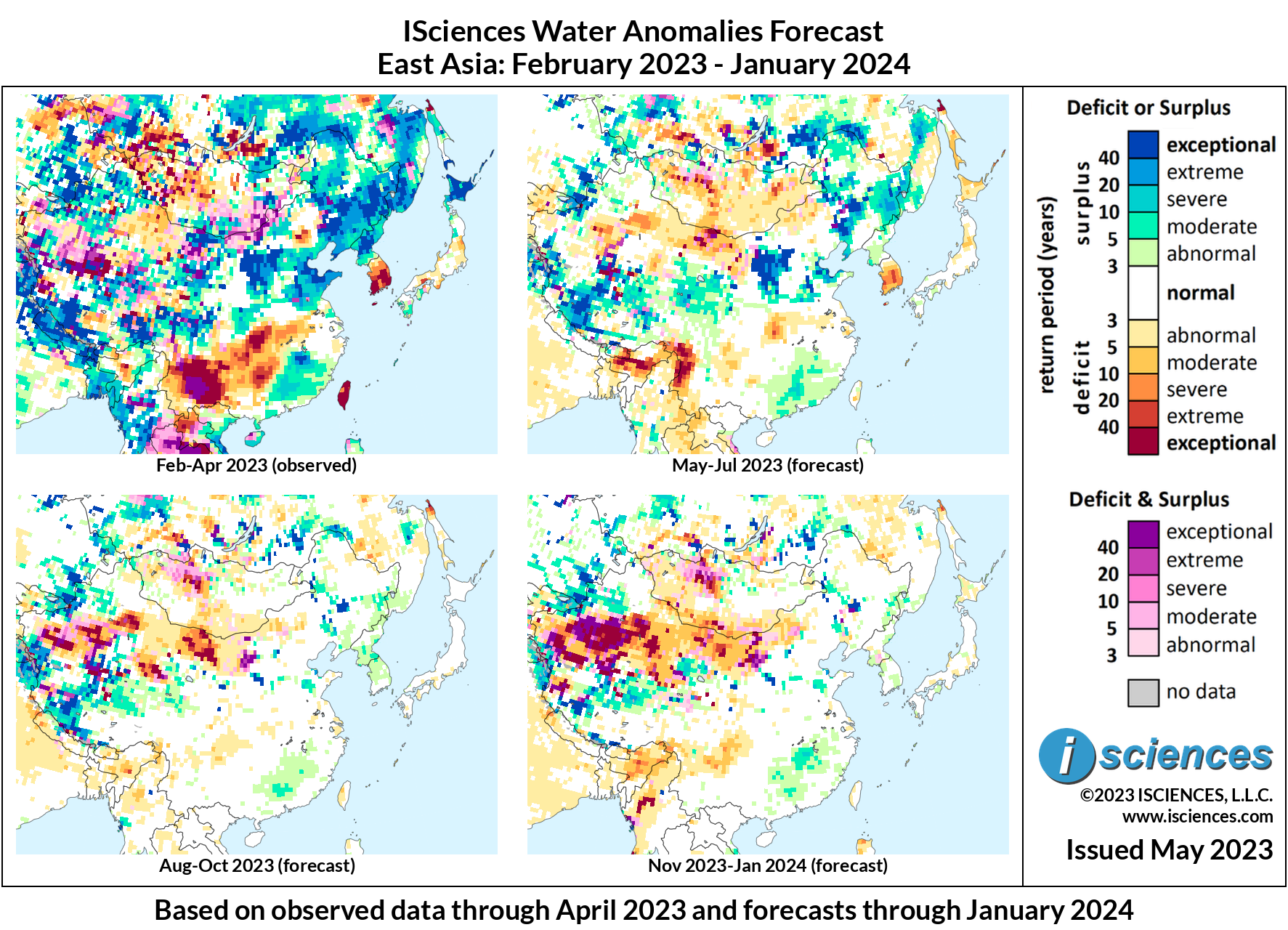East Asia: Intense deficits persist in N, NW China
26 May 2023
THE BIG PICTURE
The 12-month forecast ending in January 2024 indicates pockets of exceptional anomalies throughout East Asia, with intense deficits occurring in northern and southern regions of China, and notable surpluses in its southwestern and northeastern regions.
Extreme to exceptional deficits are anticipated in the following regions:
Northern and northwest China, throughout western Inner Mongolia and central southeastern Xinjiang.
Northwestern Mongolia, in northern regions of the Govi-Altai aimag, moving further northwest into areas near the city of Ulaangom.
Southern China, throughout western regions of the Yunnan province, into southwestern areas of the Sichuan province.
South Korea, with the most intense deficits occurring in central areas of the country.
Taiwan, throughout much of the country’s southern and central regions.
The following regions can expect extreme to exceptional surplus:
Northeast China, throughout the Shandong Peninsula, as well as western regions of the Liaoning, Jilin, and Heilongjiang provinces.
Northwest China, in northwestern Xinjiang throughout the Aksu Prefecture.
Southwestern China, spanning across much of the southwestern border of Tibet, as well as areas of the Ngari Prefecture.
Central regions of Inner Mongolia, near the Xiangguang Banner.
The 3-month maps (below) show the evolving conditions in more detail.
FORECAST BREAKDOWN
The forecast through July 2023 anticipates intense surpluses in central Inner Mongolia to persist, as well as in regions of the Liaoning, Jilin, and Heilongjiang provinces. Deficits in western Inner Mongolia are expected to mostly dissipate, becoming moderate deficits in most areas of the region. Extreme to exceptional surpluses will persist throughout Tibet, as well as in western Xinjiang. Further south, northern regions of Yunnan can expect exceptional deficits. In South Korea, extreme deficits are expected to continue.
From August to October 2023, most anomalies throughout China are expected to subside, though exceptional deficits can be expected to continue in western Inner Mongolia and eastern Xinjiang. In southwest China, exceptional surpluses are expected to persist throughout Tibet, as well as western to southwestern regions along the border of Xinjiang.
The forecast for the final months – November through January 2024 – predicts exceptional deficits and transitional conditions to re-emerge in central Xinjiang and western Inner Mongolia. Exceptional surpluses are expected to continue throughout Tibet, with mild to moderate transitional conditions in northwestern Mongolia.
Please note that WSIM forecast skill declines with longer lead times.
IMPACTS
Over the first weekend of May, floods displaced around 14,000 residents in the eastern Chinese province of Jiangxi, which led to financial losses equivalent to $75 million. As of May 4th, 107 nearby counties have recorded increased rainfall of varying intensity, with 10 counties observing precipitation levels over 250 millimeters within 24 hours. Jiangxi experienced the heaviest rainfall this year, just after prematurely entering flooding season on March 24th. Last fall, Jiangxi experienced severe drought with China’s largest freshwater lake, Poyang Lake, seeing its water level at one of its lowest recorded levels.
Potable water is becoming scarce in North Korea as the country experiences one of its worst droughts since records began in 1981. On May 9th, North Korean media reported that water scarcity could make food shortages worse, and there was a “nationwide effort to try to save crops from damage.” A source from the northwestern province of North Pyongan reported having to go to great lengths to obtain water, stating that “We carry water with a bucket, but the water supply is not working well.” “We can more easily fetch water in the winter, but the spring and fall seasons are the worst. The water pumping station is running dry and we don’t get tap water at all.”
Taiwan experienced torrential rain the evening of May 22nd, but reported that less than 5 percent stayed in reservoirs in the southern part of the island, which is experiencing drought. The rain deposited an estimated 20.25 million cubic meters of water in reservoirs in the country, but only 950,000 cubic meters went to reservoirs in the south. An additional 500,000 cubic meters of rain was deposited in the Tsengwen and Wu Shan Tou reservoirs combined, leaving them with water reserves at only 13.4 percent of capacity. Another 250,000 cubic meters were deposited in the Lantan and Renyitan reservoirs, and 150,000 cubic meters reached the Nanhua Reservoir, though they remain at barely over 20 percent of capacity.
NOTE ON ADMINISTRATIVE BOUNDARIES
There are numerous regions around the world where country borders are contested. ISciences depicts country boundaries on these maps solely to provide some geographic context. The boundaries are nominal, not legal, descriptions of each entity. The use of these boundaries does not imply any judgement on the legal status of any territory, or any endorsement or acceptance of disputed boundaries on the part of ISciences or our data providers.
Subscribe to our monthly Water Watch List
Search blog categories
- *Precip/Temp Outlooks 101
- *Press Releases 1
- *Special Topics 21
- *Water Watch Lists 127
- Africa 130
- Australia & New Zealand 114
- Canada 116
- Central Asia & Russia 114
- East Asia 115
- Europe 121
- Impact Highlights 1
- Mexico & C. Amer. & Carib 119
- Middle East 124
- Proof Point 2
- South America 130
- South Asia 120
- Southeast Asia & Pacific 123
- United States 120
Search blog tags



